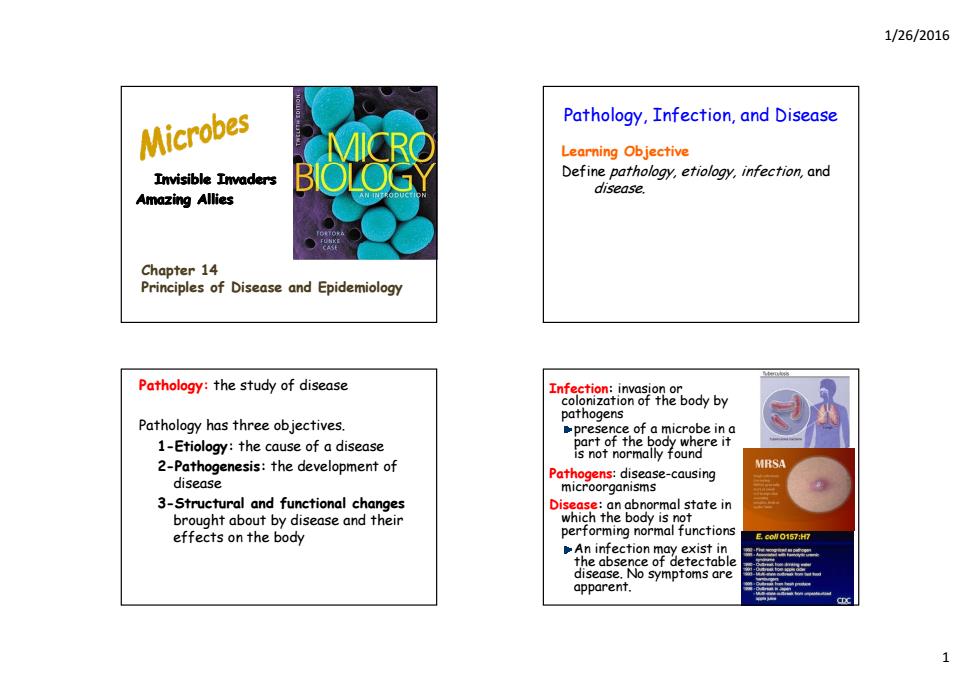
1/26/2016 Microbes Pathology,Infection,and Disease Learning Objective Invisible Invaders Define pathology,etiology,infection,and disease. Amazing Allies Chapter 14 Principles of Disease and Epidemiology Pathology:the study of disease Infection:invasion or colonization of the body by Pathology has three objectives. pathogens presence of a microbe in a 1-Etiology:the cause of a disease part of the body where it is not normally found 2-Pathogenesis:the development of MRSA disease 3-Structural and functional changes brought about by disease and their in effects on the body performing normal functions E.coW 0157:H7 An infection may exist in the absence of detectable disease.No symptoms are apparent
1/26/2016 1 Invisible Invaders Amazing Allies Chapter 14 Principles of Disease and Epidemiology Pathology, Infection, and Disease Learning Objective Define pathology, etiology, infection, and disease. Pathology: the study of disease Pathology has three objectives. 1-Etiology: the cause of a disease 2-Pathogenesis: the development of disease 3-Structural and functional changes broug y ht about by disease and their effects on the body Infection: invasion or colonization of the body by pathogens presence of a microbe in a p y art of the body where it is not normally found Pathogens: disease-causing microorganisms Disease: an abnormal state in which the body is not perf i l f ti forming normal functions An infection may exist in the absence of detectable disease. No symptoms are apparent
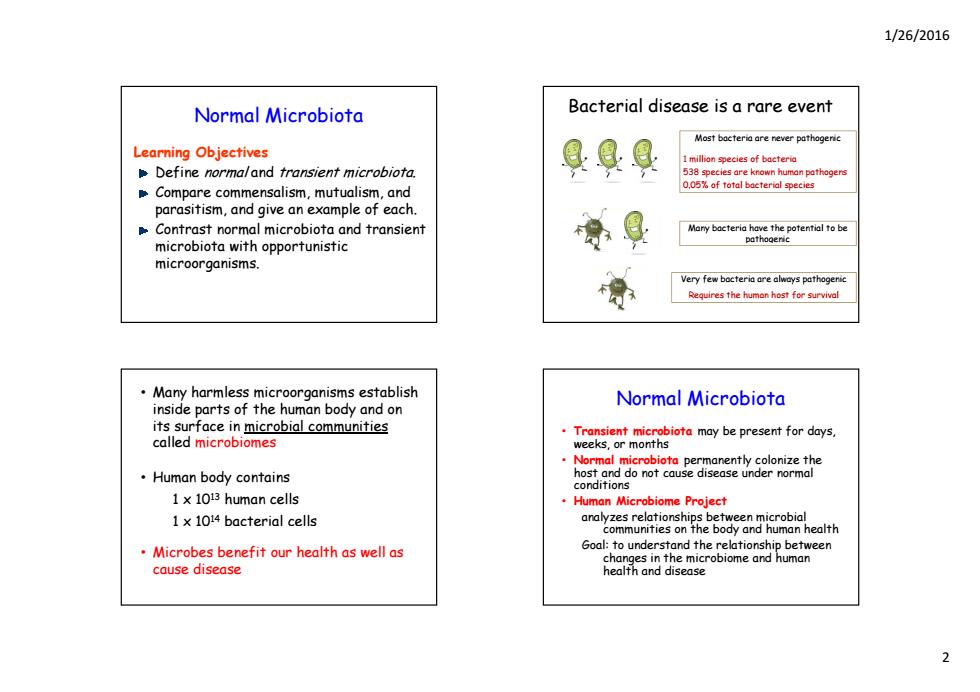
1/26/2016 Normal Microbiota Bacterial disease is a rare event Most bacteria are never pathogeric Learning Objectives Qg具 Define normaland transient microbiota. 538 species are known human pathogers Compare commensalism,mutualism,and 0.05%of total bacterial species parasitism,and give an example of each. Contrast normal microbiota and transient Many bacteria have the potential to be microbiota with opportunistic pathogeric microorganisms. Very few bocteria are always pathogenic Requires the human host for survival Many harmless microorganisms establish inside parts of the human body and on Normal Microbiota its surface in microbial communities Transient microbiota may be present for days, called microbiomes weeks,or months Normal microbiota permanently colonize the ·Human body contains host and do not cause disease under normal conditions 1x 1013 human cells Human Microbiome Project 1 x 1014 bacterial cells ween microbial Microbes benefit our health as well as Goal:to understand the relationship between human cause disease
1/26/2016 2 Normal Microbiota Learning Objectives Define normal and transient microbiota. Compare commensalism, mutualism, and parasitism, and give an example of each. Contrast normal microbiota and transient mi bi t ith pp t nisti microbiota with opportunistic microorganisms. Most bacteria are never pathogenic 1 million species of bacteria Bacterial disease is a rare event 538 species are known human pathogens 0.05% of total bacterial species Many bacteria have the potential to be pathogenic Very few bacteria are always pathogenic Requires the human host for survival • Many harmless microorganisms establish inside parts of the human body and on its surface in microbial communities called m crob omes icrobiomes • Human body contains 1 x 1013 human cells 1 x 1014 bacterial cells • Microbes benefit our health as well as cause disease Normal Microbiota • Transient microbiota may be present for days, weeks, or months • Normal microbiota permanently colonize the host and do not cause disease under normal conditions • Human Microbiome Project analyzes relationships between microbial communiti th b d d h h lth ities on the body and human health Goal: to understand the relationship between changes in the microbiome and human health and disease
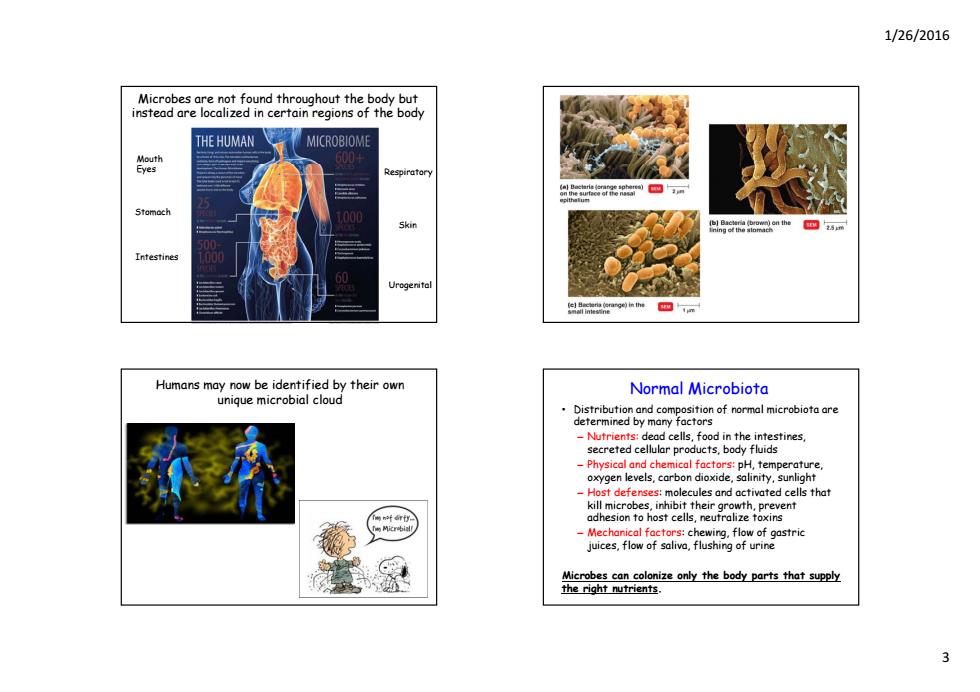
1/26/2016 Microbes are not found throughout the body but instead are localized in certain regions of the body THE HUMAN MICROBIOME Intestines Urogenita 四 Humans may now be identified by their own Normal Microbiota unique microbial cloud -Nutrients:dead cells,food in the intestines, secreted cellular products,body fluids -Physical and chemical factors:pH,temperature, oxygen levels,carbon dioxide,salinity,sunlight -Host defenses:molecules and activated cells that kill microbes inhibit theirg,prevent adhesion to host cells,neutralize toxins Mechanical factors:chewing,flow of gastric juices,flow of saliva,flushing of urine Microbes can colonize only the body parts that supply the right nutrient
1/26/2016 3 Mouth Microbes are not found throughout the body but instead are localized in certain regions of the body Stomach Skin Respiratory Eyes Intestines Urogenital Humans may now be identified by their own unique microbial cloud Normal Microbiota • Distribution and composition of normal microbiota are determined by many factors – Nutrients: dead cells, food in the intestines, s t d ll l p d ts b d fl ids secreted cellular products, body fluids – Physical and chemical factors: pH, temperature, oxygen levels, carbon dioxide, salinity, sunlight – Host defenses: molecules and activated cells that kill microbes, inhibit their growth, prevent adhesion to host cells, neutralize toxins – Mechanical factors: chewing, flow of gastric juices, flow of saliva, flushing of urine Microbes can colonize only the body parts that supply the right nutrients
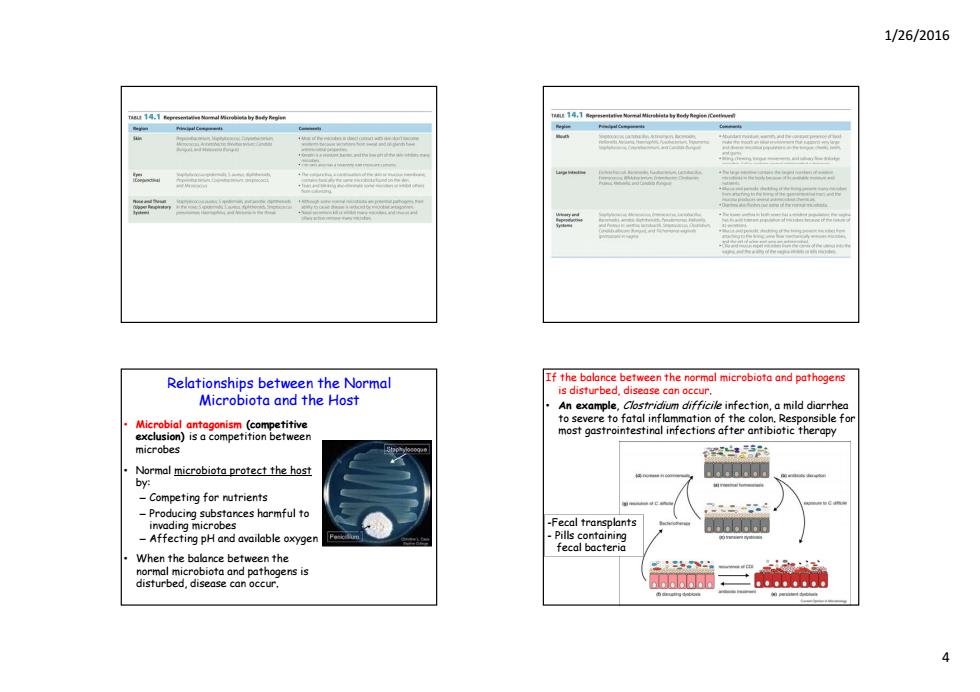
1/26/2016 Relationships between the Normal If the balance between the normal microbiota and pathogens is disturbed.disease can occur Microbiota and the Host An example,Clostridium difficile infection,a mild diarrhea Microbial antagonism (competitive to severe to fatal inflammation of the colon.Responsible for exclusion)is a competition between most gastrointestinal infections after antibiotic therapy microbes Normal microbiota protect the host by: -Competing for nutrients -Producing substances harmful to invading microbes -Fecal transplants 。。 -Affecting pH and available oxyger Pills containing fecal bacteric When the balance between the normal mic robiota and pathogens is disturbed,disease can occur
1/26/2016 4 Relationships between the Normal Microbiota and the Host • Microbial antagonism (competitive exclusion) is a competition between mi b s cro e • Normal microbiota protect the host by: – Competing for nutrients – Producing substances harmful to invading microbes – Affecting pH and available oxygen • When the balance between the normal microbiota and pathogens is disturbed, disease can occur. If the balance between the normal microbiota and pathogens is disturbed, disease can occur. • An example, Clostridium difficile infection, a mild diarrhea to severe to fatal inflammation of the colon. Responsible for most gastrointestinal infections after antibiotic therapy -F p ecal transplants - Pills containing fecal bacteria
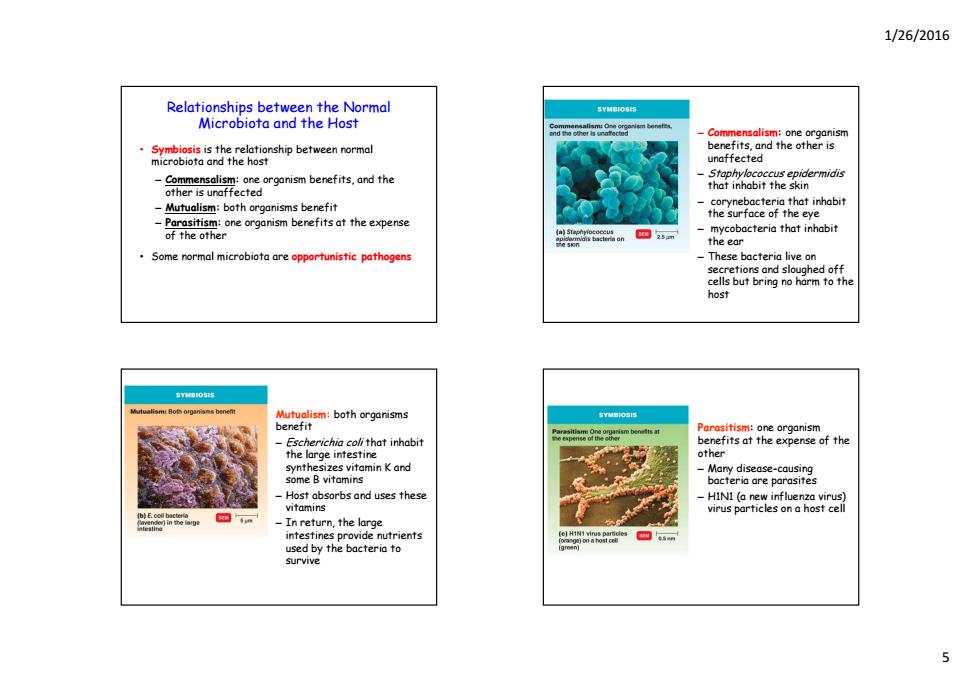
1/26/2016 Relationships between the Normal SYMRIOGES Microbiota and the Host Commensalism:one organism Symbiosis is the relationship between normal benefits,and the other is microbiota and the host unaffected -Commensalism:one organism benefits,and the Staphylococcus epidermidis other is unaffected that inhabit the skin Mutualism:both organisms benefit the surface of the eye -Parasitism:one organism benefits at the expense mycobacteria that inhabit of the other w四2 the ear Some normal microbiota are opportunistic pathogens These bacteria live on secretions and sloughed off cells but bring no harm to the host L8oog nisms bene m both Parasitism:one organism Escherichia coli that inhabit benefits at the expense of the the large intestine other Many disease-caus baec2earepaasi2 Host absorbs and uses these HIN1 (a new influenza virus) vitamins virus particles on a host cell -In return,the lar used by the bacteria to survive
1/26/2016 5 Relationships between the Normal Microbiota and the Host • Symbiosis is the relationship between normal microbiota and the host – Commensalism: one organism benefits, and the other is unaffected – Mutualism: both organisms benefit – Parasitism: one organism benefits at the expense of the other • Some normal microbiota are opportunistic pathogens – Commensalism: one organism benefits, and the other is unaffected – Staphylococcus epidermidis that inhabit the skin – corynebacteria that inhabit the surface of the eye – mycobacteria that inhabit the ear – These bacteria live on secretions and sloughed off cells but bring no harm to the host Mutualism: both organisms benefit – Escherichia coli that inhabit the large intestine synthesizes vitamin K and some B vitamins – Host absorbs and uses these vitamins – In return, the large intestines provide nutrients used by the bacteria to survive Parasitism: one organism benefits at the expense of the other – Many disease-causing bacteria are parasites – H1N1 (a new influenza virus) virus particles on a host cell
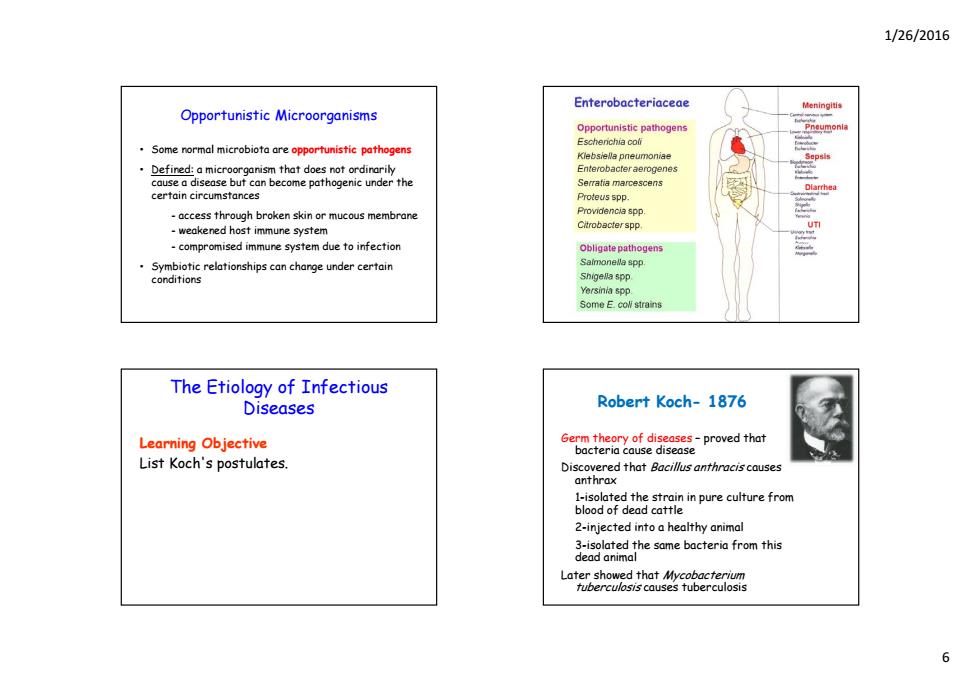
1/26/2016 Enterobacteriaceae Opportunistic Microorganisms Opportunistic pathogens Eschenchia col Some normal microbiota are opportunistic pathogens Klebsiella pneumoniae cause a dis r the Serratia marcescens certain circumstances Proteus spp. access through broken skin or mucous membrane Providencia spp. weakened host immune system -compromised immune system due to infection Obligate pathogens Symbiotic relationships can change under certain Saimonella spp. conditions Shigella spp Yersinia spp Some E coW strains The Etiology of Infectious Diseases Robert Koch-1876 Learning Objective List Koch's postulates. Discovered that Bacillus anthracis causes anthrax 1-isolated the strain in pure culture from blood of dead cattle 2-injected into a healthy animal 3-isolated the same bacteria from this dead animal latb2eweetatsRbeterosg tuber 6
1/26/2016 6 Opportunistic Microorganisms • Some normal microbiota are opportunistic pathogens • Defined: a microorganism that does not ordinarily cause a disease but can become pathogenic under the certain circumstances - access through broken skin or mucous membrane - weakened host immune system - compromis d i s st d t i f ti ised immune system due to infection • Symbiotic relationships can change under certain conditions The Etiology of Infectious Diseases Learning Objective List Koch's postulates. Robert Koch- 1876 Germ theory of diseases – proved that b t i s dis s bacteria cause disease Discovered that Bacillus anthracis causes anthrax 1-isolated the strain in pure culture from blood of dead cattle 2-injected into a healthy animal 3-isolated the same bacteria from this dead animal Later showed that Mycobacterium tuberculosis causes tuberculosis
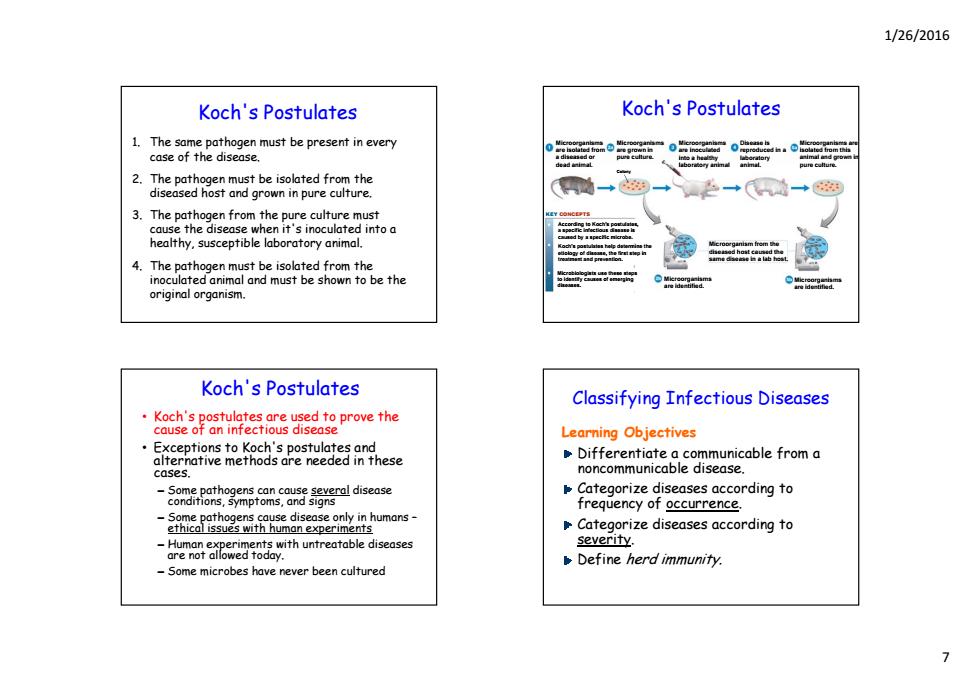
1/26/2016 Koch's Postulates Koch's Postulates 1.The same pathogen must be present in every case of the disease. 2.The pathogen must be isolated from the diseased host and grown in pure culture. 3.The pathogen from the pure culture must cause the disease when it's inoculated into a healthy.susceptible laboratory animal. 4.The pathogen must be isolated from the inoculated animal and must be shown to be the 2 original organism. Koch's Postulates Classifying Infectious Diseases Koch's postulates are used to prove the cause of an infectious disease Learning Objectives Exceptions to Koch's postulates and alternative methods are needed in these Differentiate a communicable from a cases. noncommunicable disease. -Some pathogens can cause several disease Categorize diseases according to conditions,symptoms,and signs frequency of occurrence. Categorize diseases according to -tenreieeaf8ayrthuntreatobedseascs severity. Define herd immunity. Some microbes have never been cultured
1/26/2016 7 Koch's Postulates 1. The same pathogen must be present in every case of the disease. 2. The pathogen must be isolated from the diseased host and grown in pure culture. 3. The pathogen from the pure culture must cause the disease when it's inoculated into a healthy susceptible laboratory animal healthy, susceptible laboratory animal. 4. The pathogen must be isolated from the inoculated animal and must be shown to be the original organism. Microorganisms are isolated from a diseased or dead animal Microorganisms are grown in pure culture. Microorganisms are inoculated into a healthy laboratory animal Disease is reproduced in a laboratory animal Microorganisms are isolated from this animal and grown in pure culture Koch's Postulates KEY CONCEPTS dead animal. laboratory animal animal. pure culture. Colony Microorganism from the According to Koch's postulates, a specific infectious disease is caused by a specific microbe. from the diseased host caused the same disease in a lab host. Microorganisms are identified. Microorganisms are identified. Microbiologists use these steps to identify causes of emerging diseases. Koch's postulates help determine the etiology of disease, the first step in treatment and prevention. Koch's Postulates • Koch's postulates are used to prove the cause of an infectious disease • Exceptions to Koch's postulates and alternative methods are needed in these cases. – Some pathogens can cause several disease conditions, symptoms, and signs – Some pathogens cause disease only in humans – ethical issues with human experiments – Human experiments with untreatable diseases are not allowed today. – Some microbes have never been cultured Classifying Infectious Diseases Learning Objectives Diff i i bl f Differentiate a communicable from a noncommunicable disease. Categorize diseases according to frequency of occurrence. Categorize diseases according to severity. Define herd immunity
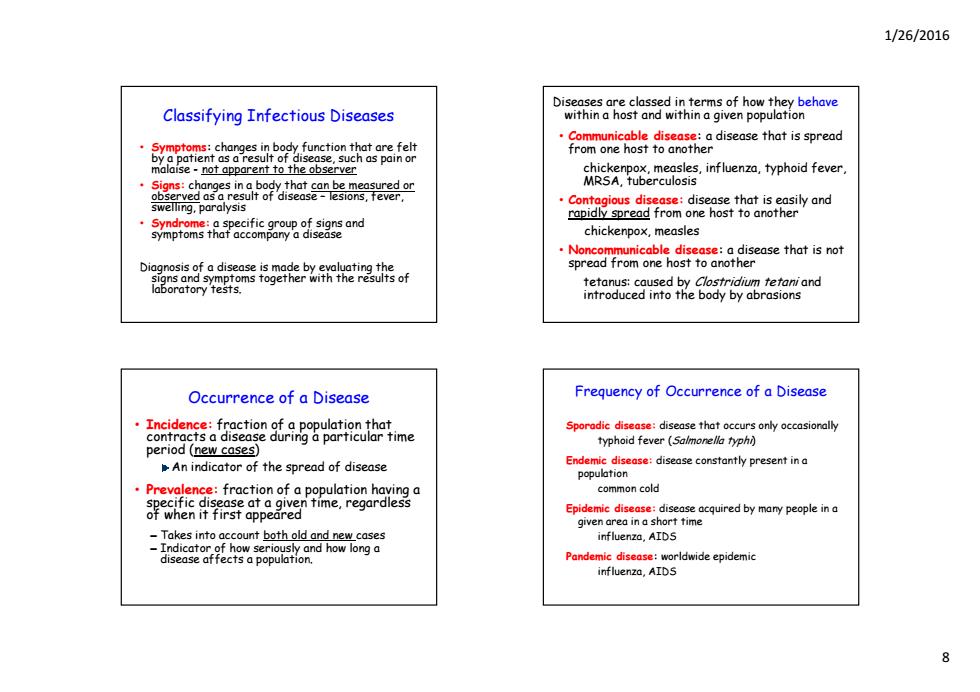
1/26/2016 Diseases are classed in terms of how they behave Classifying Infectious Diseases within a host and within a given population Communicable disease:a disease that is spread from one host to another chickenpox,measles,influenza,typhoid fever, 82a29b8a29eom0恩r MRSA.tuberculosis swelling,paralysis ‘e6eog1od8eyod chickenpox,measles Noncommunicable disease:a disease that is not spread from one host to another tetanus:caused by Clostridium tetani and introduced into the body by abrasions Occurrence of a Disease Frequency of Occurrence of a Disease Incidence:fraction of a population that Sporadic disease:disease that occurs only occasionally contracts a disease during a particular time period(new cases) typhoid fever (Salmonella typhi) An indicator of the spread of disease Endemic disease:disease constantly present in a population Prevalence:fraction of a population having a common cold specific disease at a given time,regardless of when it first appeared Epidemic disease:disease acquired by many people in a given area in a short time -Takes into account both old and new cases influenza,AIDS rpopuhn Pandemic disease:worldwide epidemic influenza,AIDS
1/26/2016 8 Classifying Infectious Diseases • Symptoms: changes in body function that are felt by a patient as a result of disease, such as pain or li h b yp p malaise - not apparent to the observer • Signs: changes in a body that can be measured or observed as a result of disease – lesions, fever, swelling, paralysis • Syndrome: a specific group of signs and symptoms that accompany a disease Diagnosis of a disease is made by evaluating the signs and symptoms together with the results of laboratory tests. Diseases are classed in terms of how they behave within a host and within a given population • Communicable disease: a disease that is spread from one host to another chi k l i fl t h id f hickenpox, measles, influenza, typhoid fever, MRSA, tuberculosis • Contagious disease: disease that is easily and rapidly spread from one host to another chickenpox, measles • Noncommunicable disease: a disease that is not spread from one host to another tetanus: caused by Clostridium tetani and introduced into the body by abrasions Occurrence of a Disease • Incidence: fraction of a population that contracts a disease during a particular time period (new cases) An indicator of the spread of disease • Prevalence: fraction of a population having a specific disease at a given time, regardless of when it first appeared – Takes into account both old and new cases – Indicator of how seriously and how long a disease affects a population. Sporadic disease: disease that occurs only occasionally typhoid fever (Salmonella typhi) Frequency of Occurrence of a Disease Endemic disease: disease constantly present in a population common cold Epidemic disease: disease acquired by many people in a given area in a short time influenza, AIDS Pandemic disease: worldwide epidemic influenza, AIDS
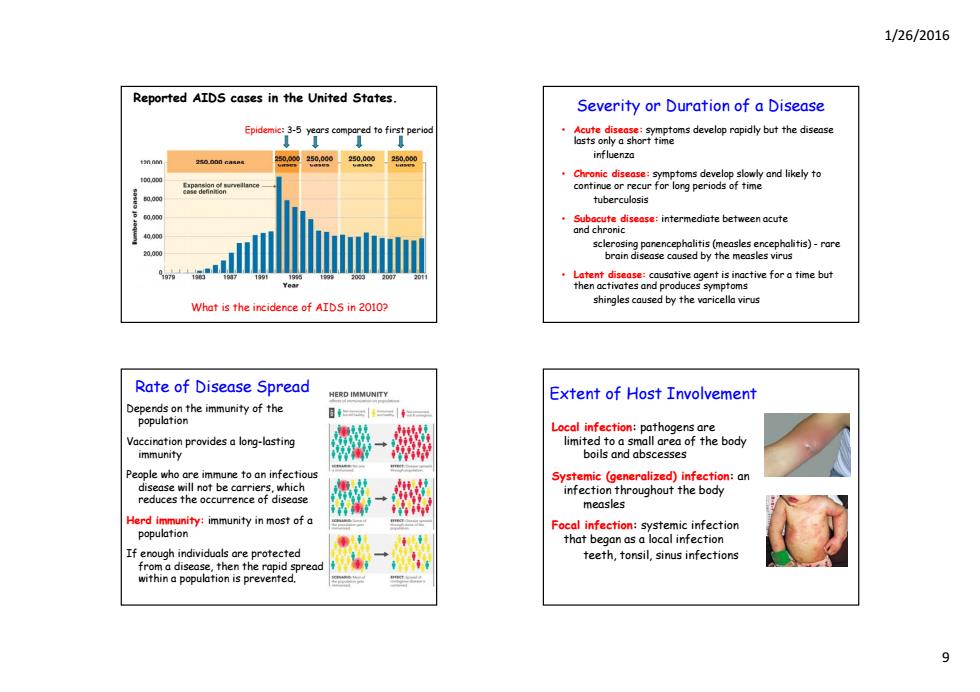
1/26/2016 Reported AIDS cases in the United States. Severity or Duration of a Disease Epidemic: 3-5 years compared to first perio 00250,000 250.00 influenza Chronic disease:symptoms develop slowly and likely to 6000 continue or recur for long periods of time tuberculosis 0,0 sclerosing panencephalitis(measles encephalitis)-rare 2000 brain disease caused by the measles virus Ye the ve fortme u shingles caused by the varicella virus What is the incidence of AIDS in 2010? Rate of Disease Spread HERD IMMUNITY Extent of Host Involvement Depends on the immunity of the population 目e三| Local infection:pathogens are Vaccination provides a long-lasting limited to a small area of the body immunity boils and abscesses Systemic (generalized)infection:an 型- infection throughout the body measles Herd immunity:immunity in most of a population Focal infection:systemic infection that began as a local infection If enough individuals are protected teeth,tonsil,sinus infections from a disease,then the rapid spread within a population is prevented
1/26/2016 9 Reported AIDS cases in the United States. Epidemic: 3-5 years compared to first period What is the incidence of AIDS in 2010? Severity or Duration of a Disease • Acute disease: symptoms develop rapidly but the disease lasts only a short time influenza • Chronic disease: symptoms develop slowly and likely to continue or recur for long periods of time tuberculosis • Subacute disease: intermediate between acute and chronic sclerosing panencephalitis (measles encephalitis) - rare brain disease caused by the measles virus • Latent disease: causative agent is inactive for a time but then activates and produces symptoms shingles caused by the varicella virus Rate of Disease Spread Depends on the immunity of the population Vaccination p g rovides a long-lasting immunity People who are immune to an infectious disease will not be carriers, which reduces the occurrence of disease Herd immunity: immunity in most of a population If enough individuals are protected from a disease, then the rapid spread within a population is prevented. Extent of Host Involvement Local infection: pathogens are limited to a small area of the body boils and abscesses Systemic (generalized) infection: an infection throughout the body measles Focal infection: systemic infection that began as a local infection teeth, tonsil, sinus infections

1/26/2016 Extent of Host Involvement Extent of Host Involvement Toxemia:toxins in the blood Sepsis:toxic inflammatory condition Viremia:viruses in the blood arising from the spread of microbes, Primary infection:acute infection that causes especially bacteria or their toxins,from the initial illness a focus of infection Secondary infection:opportunistic infection Bacteremia:bacteria in the blood after a primary infection Septicemia:also known as blood poisoning: -Pneumocystis pneumonia in AIDS patients growth of bacteria in the blood. Subclinical disease:no noticeable signs or example of sepsis symptoms(inapparent infection) nbe peleour Patterns of Disease Predisposing Factors Occurrence of disease depends on the resistance Learning Objectives of the host to the activities of the pathogen. Identify four predisposing factors Factors that make the body more susceptible to for disease. disease -Gender Put the following in proper sequence, -Inherited traits,such as the sickle cell gene according to the pattern of disease: -Climate and weather period of decline,period of convalescence, -Fatigue period of illness,prodromal period, -Age incubation period. -Lifestyle -Nutrition -Chemotherapy 10
1/26/2016 10 Extent of Host Involvement Sepsis: toxic inflammatory condition ari i f th d f i b ising from th e spread of micro bes, especially bacteria or their toxins, from a focus of infection Bacteremia: bacteria in the blood Septicemia: also known as blood poisoning; growth of bacteria in the blood, example of sepsis Extent of Host Involvement Toxemia: toxins in the blood Viremia: viruses in the blood Prim r inf cti n: Prim ary inf ecti on: acut inf cti n th t c us s cut e inf ecti on th at c aus es the initial illness Secondary infection: opportunistic infection after a primary infection - Pneumocystis pneumonia in AIDS patients Subclinical disease: no noticeable signs or symptoms (inapparent infection) - polio virus can be carried by people without symptoms Patterns of Disease Learning Objectives Identify four predisposing factors for disease. Put the following in proper sequence, accordin g p to the pattern of disease: period of decline, period of convalescence, period of illness, prodromal period, incubation period. Predisposing Factors Occurrence of disease depends on the resistance of the host to the activities of the pathogen. F h k h b d ibl Factors that ma k e th e b o d y more susceptibl e to disease – Gender – Inherited traits, such as the sickle cell gene – Climate and weather – F ti ue Fatigue – Age – Lifestyle – Nutrition – Chemotherapy